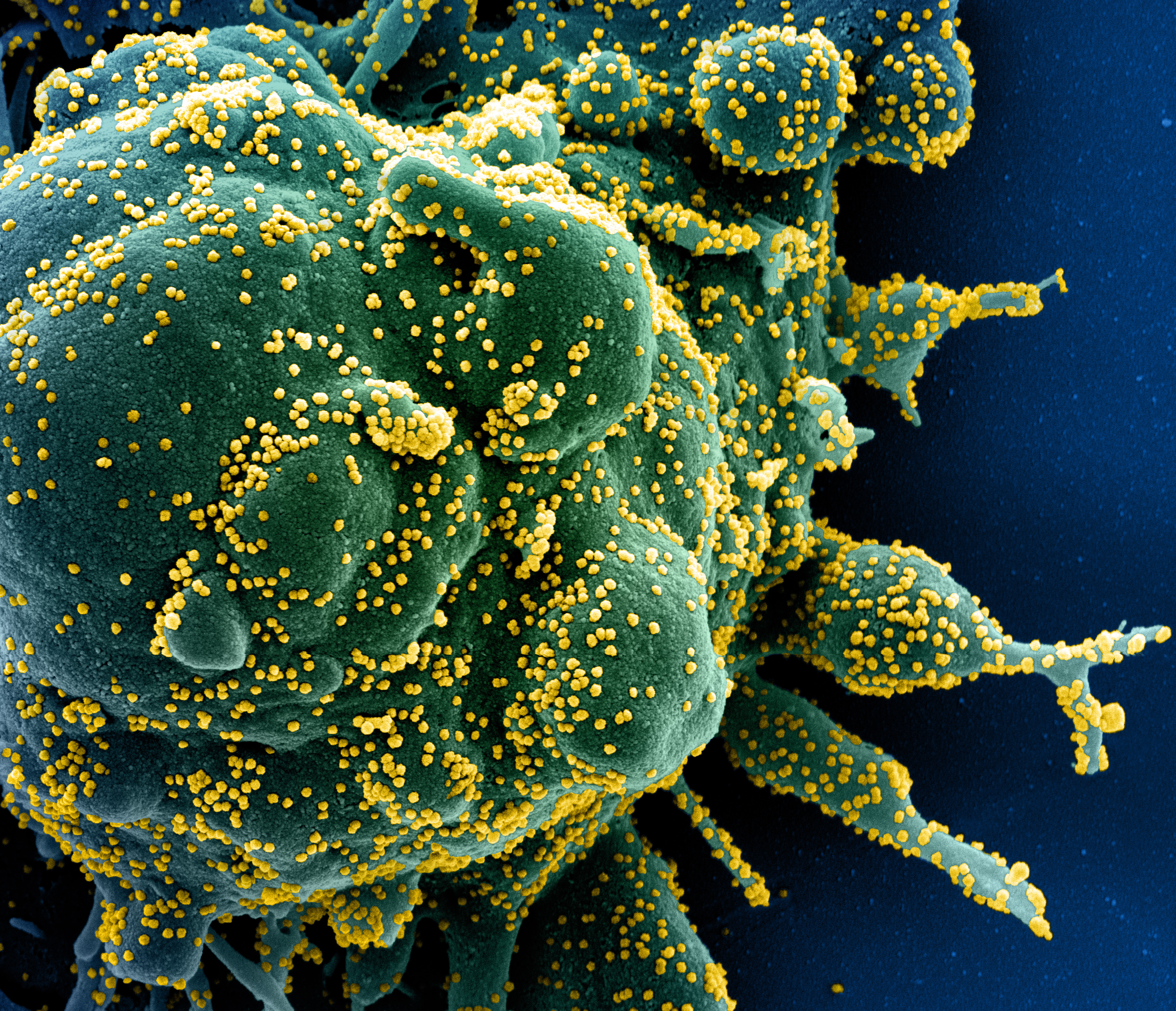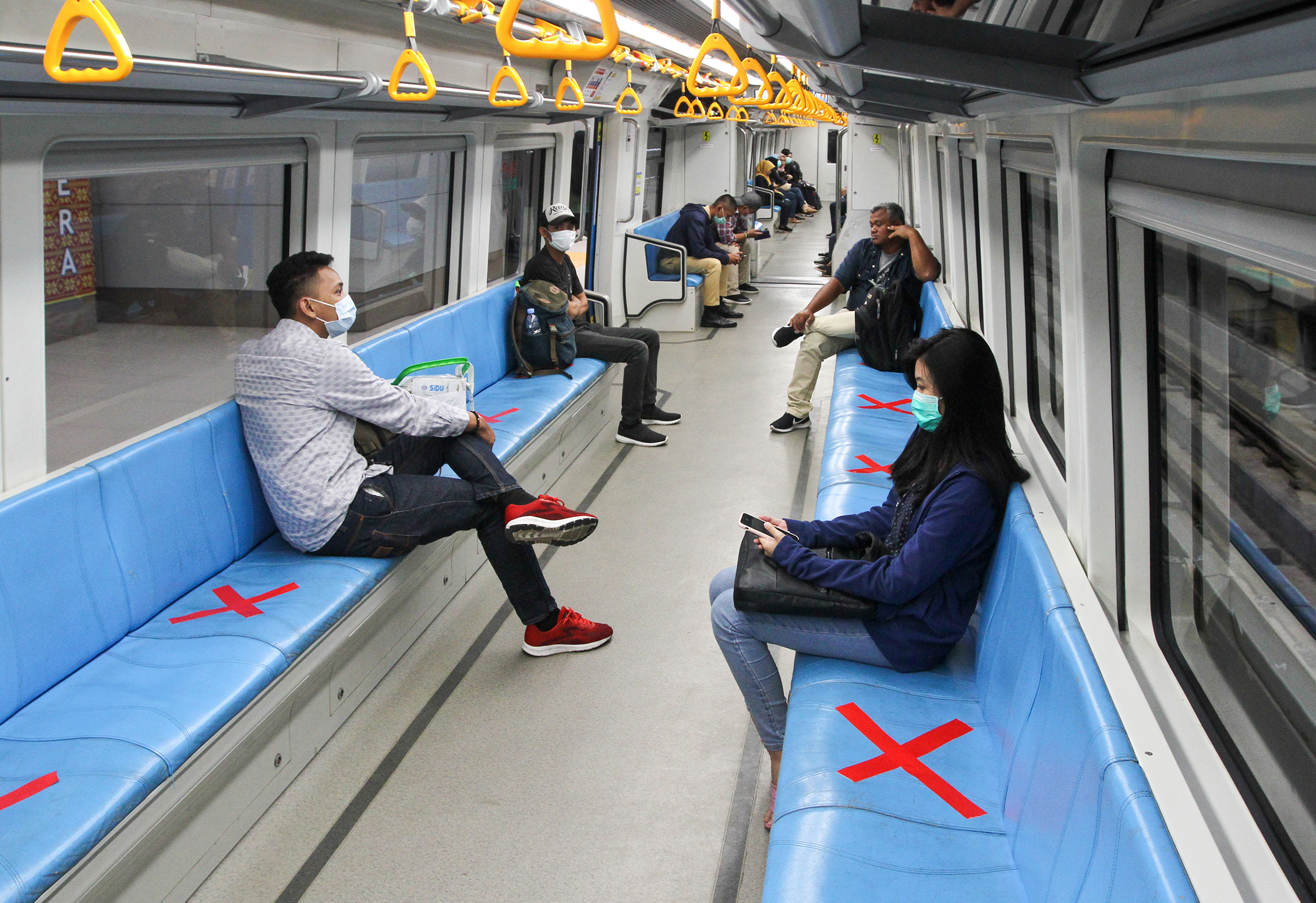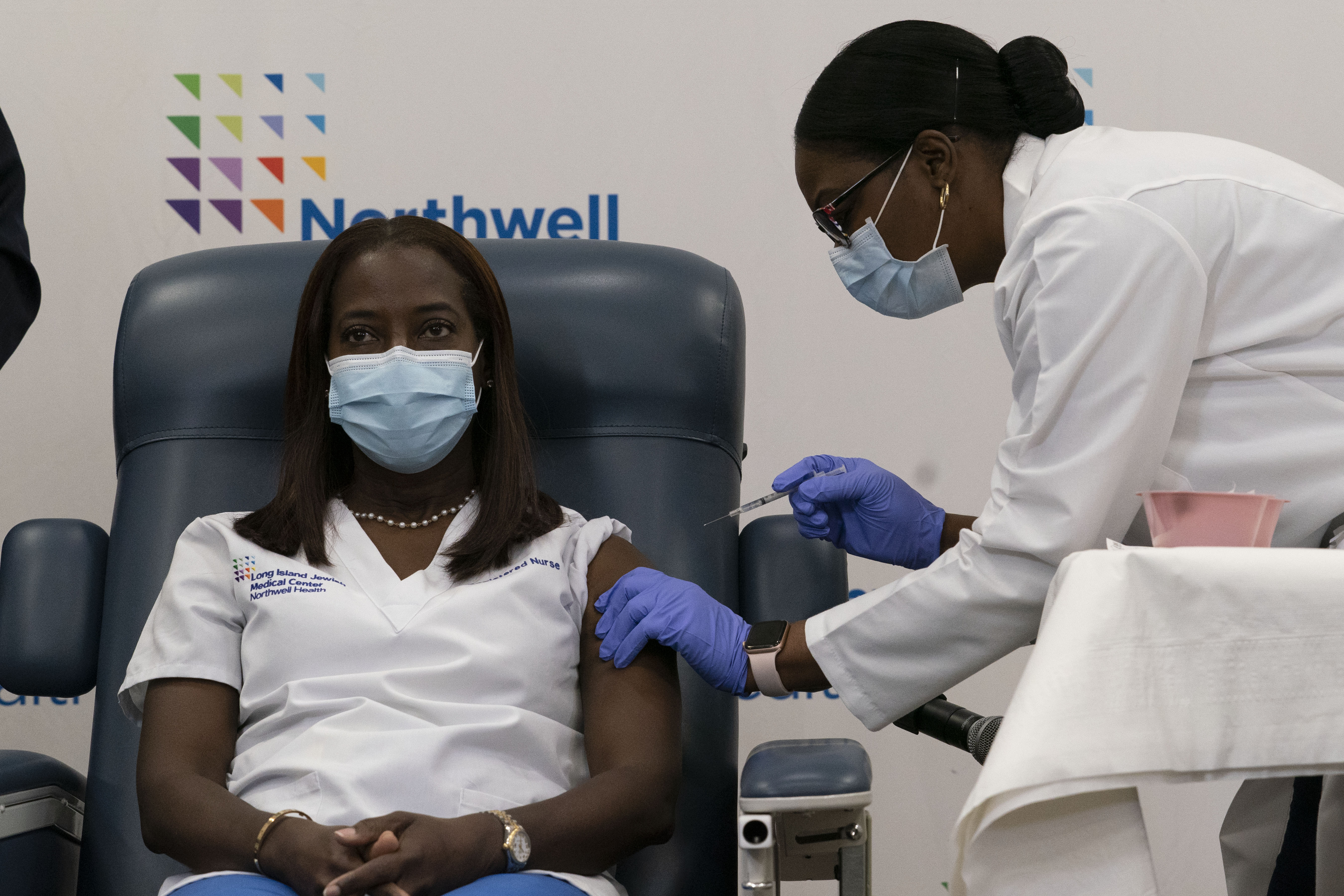COVID-19 is a contagious respiratory disease. COVID-19 is caused by a coronavirus called SARS-CoV-2. Coronaviruses are a group of viruses that cause diseases of the respiratory system. In 2020, the World Health Organization (WHO) declared COVID-19 a global pandemic—that is, an outbreak of disease that has spread around the world.
Symptoms and treatment
Symptoms
of COVID-19 include fever, cough, difficulty breathing, fatigue, headache, muscle or body aches, loss of sense of taste or smell, congestion or runny nose, sore throat, nausea, and diarrhea. An infected person usually shows symptoms 2 to 14 days after exposure to the virus. Not everyone who contracts COVID-19 shows symptoms.

In a small percentage of cases, COVID-19 can be fatal. Most people recover from the disease within a few weeks.
Vaccination against COVID-19 reduces the likelihood of becoming infected. Vaccines also are highly effective in preventing serious illness or death when an infection does occur in a vaccinated person.
Treatment.
Usually, people who are mildly ill with COVID-19 can recover at home. To treat symptoms, most people can take nonprescription drugs such as acetaminophen or ibuprofen.
In some cases, doctors may prescribe drugs or special treatments for COVID-19. Such treatments are usually prescribed to patients who risk developing severe symptoms. In the United States, the Food and Drug Administration (FDA) has approved the drug remdesivir to treat COVID-19. Remdesivir is given intravenously (in a patient’s veins).
Other COVID-19 treatments have received emergency approval from the FDA. These treatments have been shown to reduce deaths and decrease hospitalization time among patients. Such treatments include medicines that are taken as pills, as well as convalescent plasma therapy. Convalescent plasma therapy uses blood donated by people who have recovered from COVID-19. Liquid and antibodies are extracted from the donated blood and given to the patient. The antibodies are molecules that were produced by the donor’s immune system to attack the SARS-CoV-2 virus. These antibodies may help a patient’s body fight the virus and prevent the symptoms from becoming life-threatening.
Patients whose symptoms are so severe that they cannot breathe may need to be attached to a machine called a ventilator or respirator. The machine does not fight the infection, but it keeps patients breathing until their body recovers from the disease.
Long COVID.
Some patients experience COVID-19 symptoms that persist after they recover from infection. Such long-term symptoms may include those of the initial infection, as well as cognitive (thinking) problems, depression, and joint pain. This condition is known as long COVID or as post-COVID syndrome.
Most people recover from long COVID within months. However, some patients take years to recover. In many cases, long COVID becomes a disability, similar to disorders such as chronic fatigue syndrome. Those with long COVID may not be able to work, care for their family, or take part in everyday activities.
Doctors do not know how to prevent long COVID. But they know certain factors make a patient more likely to experience long-lasting symptoms after a COVID-19 infection. For example, people who smoke, who are overweight, or who become severely ill with COVID-19 are more likely to have long COVID. However, people without these factors can also get long COVID. In addition, women are twice as likely as men to experience long COVID after an infection.
There is no established cure for long COVID. Vaccination against COVID-19 reduces the likelihood of experiencing long-lasting symptoms. Physical therapy or occupational therapy can help relieve some long-COVID symptoms.
The COVID-19 pandemic
COVID-19 first appeared in humans in late 2019. The disease rapidly spread around the world. On Jan. 30, 2020, WHO declared the spread of COVID-19 to be a public health emergency of international concern. By March 2020, COVID-19 had spread to 114 countries. The disease had caused more than 118,000 infections and 4,200 confirmed deaths. On March 11, 2020, WHO announced that the worldwide outbreak of the disease was officially considered a pandemic.
By three years after the start of the pandemic, COVID-19 had caused more than 6.8 million confirmed deaths worldwide, and there had been more than 675 million confirmed cases. However, health experts think there were 4 to 10 times as many actual cases. The number of confirmed cases included patients whose test results showed they were infected with SARS-CoV-2. But many people used self-testing kits and may not have reported their test result to their doctor. Health agencies do not know how many positive self-test results went unreported. Additionally, people who showed no symptoms or only mild symptoms may not have realized they were infected, and so may not have taken a test at all.
Millions of additional deaths were probably caused by the pandemic. For several years, the number of deaths worldwide was significantly higher than usual. This rise in the death rate is called excess mortality. Researchers estimate 15 million more people died in 2020 and 2021 than would normally have been expected in a two-year period. But only about one-third of those people certainly died of COVID-19. Some of the excess deaths were probably caused by uncounted cases of COVID-19. Experts think the pandemic also increased deaths by non-COVID causes, though it is not clear why it would have done so.
WHO ended the officially declared public health emergency on May 5, 2023. From that date, the COVID-19 pandemic was no longer considered a temporary crisis, but a permanent public health issue.
Discovery of the new coronavirus.
By analyzing the SARS-CoV-2 virus, scientists can tell that COVID-19 is a zoonotic disease—that is, a disease that originated in animals and then spread to human beings. However, authorities have not positively determined how COVID-19 first spread to human beings.
COVID-19 probably first developed in bats, like the related disease SARS (severe acute respiratory syndrome). SARS most likely passed from bats to other animals, which were then brought to a live animal market to be sold as food. At the market, the infected animals transmitted SARS to people. Generally, public health experts and government agencies think COVID-19 probably first spread to humans in a similar way.

The first cases of COVID-19 in humans occurred near a seafood and live animal market in Wuhan, China. Many of the first people who became sick with COVID-19 had visited the market. Shortly after COVID-19 appeared in humans, investigators detected SARS-CoV-2 on objects and surfaces at the market.
However, some government agencies believe that SARS-CoV-2 likely spread to humans by accident from the Wuhan Institute of Virology, a laboratory where scientists study coronaviruses. No evidence available to the public suggests that this laboratory was studying SARS-CoV-2 or that COVID-19 spread from the laboratory. However, some U.S. government agencies claim that classified (secret) information shows there were safety problems at the laboratory.
Attempts to slow transmission.
SARS-CoV-2 was soon detected in the area surrounding Wuhan. In an effort to stop the spread of the virus, Chinese authorities restricted travel. Public events were canceled, and screening for the disease was instituted at airports in China and around the world. Despite these efforts, the first case of COVID-19 outside China was confirmed in January 2020, in Thailand. Cases were soon reported in other Asian countries, and then in nations throughout the world.
When COVID-19 began to spread worldwide, many countries took such steps as suspending international flights and quarantining (isolating) travelers arriving from countries with many cases of COVID-19, to prevent further spread of the virus. In addition, local governments urged people to quarantine if they had symptoms of COVID-19 or had come in contact with travelers from infected areas.
As the pandemic progressed, health care resources became strained. Hospitals began to run out of both space for patients and protective equipment for health care workers. To lower the number of COVID-19 infections, some authorities closed schools and such nonessential businesses as restaurants, movie theaters, and salons. Some officials issued stay-at-home orders. The orders forbade people to leave their homes except for such necessary activities as working at an essential job, buying food, or seeing a doctor. 
Contact tracing.
Authorities used contact tracing to help limit the early spread of the virus within communities. In this process, public health workers identify an infected person, and then attempt to identify all the people who might have had contact with that person. By doing so, they can identify other people who might have been infected. Those individuals can be tested for the virus, and, if their test results are positive, they can self-quarantine. These measures work to break the transmission of the virus from person to person within a community. However, when many people are infected in a given area, it may be impossible to reliably carry out contact tracing.
Personal protective equipment.
As the disease spread and more and more people became seriously ill, hospitals in many countries began to experience shortages of personal protective equipment (PPE). PPE helps keep health care workers safe from a number of hazards, including patients infected with a contagious disease. It includes such items as gloves, safety glasses, face masks, respirators, and full-body suits. Governments took steps to help hospitals acquire large quantities of PPE. They also urged people not to hoard (save and store) PPE for personal use. 
Methods to prevent infection.
While COVID-19 vaccines were being developed, health authorities recommended simple measures to help prevent the spread of SARS-CoV-2. They suggested that people wash their hands frequently with soap and water for at least 20 seconds and refrain from touching their eyes, nose, or mouth. They urged people to use a hand sanitizer when soap and water were not available. Hand sanitizers contain alcohol, which breaks open the membranes (outer layers) of SARS-CoV-2 so that the virus can no longer infect cells.
Authorities also urged people to practice physical distancing (popularly called social distancing)—that is, minimizing physical contact with other people by taking such steps as working from home, avoiding public gatherings, and maintaining a distance of at least 6 feet (2 meters) from other people. Health experts also strongly recommended wearing a mask over the nose and mouth. Wearing a mask helps contain the virus-carrying droplets of moisture that are spread by speaking, coughing, or sneezing. 

Pharmaceutical companies quickly developed vaccines against COVID-19, tested their safety and effectiveness, and received emergency approval from regulatory agencies to distribute them. Some countries, including Russia, the United Kingdom, and the United States, began administering vaccines in late 2020. Where vaccines were available, they were usually administered first to health care workers and other people considered at high risk of becoming ill with COVID-19. In 2021, vaccines became available in more countries. Different vaccines were distributed in different regions.
As experts collected more data, COVID-19 vaccines began to receive full approval for regular use. Comirnaty, the vaccine manufactured by a partnership of the pharmaceutical companies Pfizer and BioNTech, and Spikevax, manufactured by Moderna, received full approval from the FDA in the United States.
In late 2021, the U.S. Centers for Disease Control and Prevention (CDC) recommended COVID-19 booster shots. A booster shot is an additional dose of a vaccine that helps the body maintain immunity. Immunization experts expressed concern that booster shots were being introduced in wealthy countries while many people around the world were still waiting to receive their first vaccine dose. They argued that this imbalance would prolong the pandemic.
Global impact of COVID-19.
As COVID-19 spread around the world, its impact in different countries varied. China, where the disease was first identified, had experience dealing with similar epidemics, such as the SARS epidemic of 2003. Authorities there, and in Australia, Japan, New Zealand, and South Korea, quickly imposed strict lockdown measures that helped limit the spread of COVID-19 and the number of deaths. Lockdown measures are restrictions imposed on personal movements and various activities. In other nations, including the United States and a number of countries in Africa, Europe, and South America, officials were slower to react. 
The pandemic severely impacted the global economy. As many countries closed their borders, the tourism industry suffered huge financial losses. Border closures and lockdowns hampered the movement of goods and raw materials, causing shortages of consumer products.
Safety restrictions such as lockdowns resulted in widespread hardships. Some businesses closed temporarily to ensure the safety of customers and employees. Other businesses closed permanently because, without customers, they could not afford to continue operating. Tens of millions of workers lost their jobs. Many countries had not experienced such a level of unemployment since the Great Depression of the 1930’s. Large numbers of people reported feeling lonely and depressed as travel restrictions and quarantines isolated them from friends, family, classmates, and colleagues.
Schools around the world closed temporarily to prevent the spread of COVID-19. Many offered remote learning—that is, they instructed students who were not physically present by using such materials as workbooks, radio, television, or computers. Some research suggests that long periods of remote learning hindered children’s social and emotional development. Researchers think students from poorer families were affected the most.
Lastly, in the United States, closed doctors offices, financial hardships, and fear of contracting COVID-19 discouraged people from seeking nonurgent health care. Doctors expressed concern that missing or delaying checkups, immunizations, and surgeries would endanger patients’ health in the long term.
After the initial spread of COVID-19, there were several periods when the number of infections increased sharply throughout the world, or throughout a large region. A period with exceptionally high rates of infection is often called a wave of the disease, though experts emphasize that this term does not have a scientific definition. New waves of infection often caused authorities to tighten restrictions on business and social activities, or to reinstate restrictions that had been temporarily lifted.
Waves of COVID-19 have been influenced by many factors. In some areas, cases have increased when local governments have lifted safety restrictions, such as limiting gatherings or requiring face masks in public. But even areas that have mandated such precautions have experienced waves of the disease. This could be because the mandates were not enforced, because people were unwilling to follow them, or because the specific precautions chosen were not effective in slowing the spread of disease. Finally, a major factor in worldwide waves of COVID-19 has been the emergence of new variants (strains) of the virus that causes the disease.
Variants.
Two major variants of SARS-CoV-2 have been Delta and Omicron. Delta sharply increased the number of COVID-19 infections worldwide in mid-2021. Most infections were found among unvaccinated people. In late 2021, Omicron became the dominant variant in the United States and elsewhere. Omicron typically caused less severe illness than other variants. However, because it spread easily and infected large numbers of people, the numbers of severe cases and deaths rose rapidly. Unlike Delta, Omicron infected large numbers of both unvaccinated and vaccinated people.
Long-term effects of the pandemic.
Experts think that COVID-19 cannot be eradicated (eliminated) completely. The disease spreads too easily. New variants of the virus, which develop frequently, may require different vaccines or treatments. In addition, COVID-19 infects many kinds of animals, including cats, dogs, minks, deer, and apes. Even if COVID-19 were eradicated in human beings, an infected animal could pass the disease to a human and cause it to spread again.
Unequally distributed health care makes it difficult to protect some people from COVID-19. In 2024, 30 percent of the world’s population had not yet been vaccinated against COVID-19. People in wealthy countries had received multiple vaccine doses, as well as booster shots, while many people in poorer countries had not yet received a first vaccine dose. This inequality could make poorer countries especially vulnerable to future variants of the virus.
Health researchers believe it is urgent to study long COVID. A significant percentage of COVID-19 patients develop long COVID. If COVID-19 continues to infect people regularly, millions of people could become permanently disabled by long COVID. Doctors and scientists are still working to understand the causes of long COVID and to develop treatments for it.
